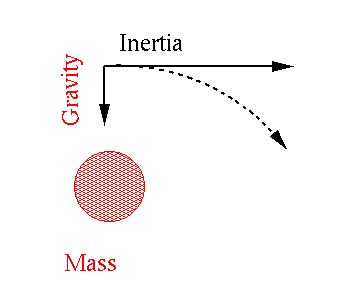 Physics Emerges
Physics Emerges
 Physics Emerges
Physics Emerges
The genius of Newton was his ability to
use calculus and coordinate transformations to reveal and explain the underlying
physics.
Calculus as a Language
For example, how do I compute the area of a circle.
A circle is enclosed by a surface when a line of radius r that has been rotated through 360 (2π) degrees.
From the language of Calculus this means the following:

Language should evolve so that communication becomes more efficient; i.e. the above graphic shows how to derive the area of a circle in using the least amount of characters and symbols. It is only meaningful if you understand the language
Newtonian Physics:

Newton invented a scientific method which was truly universal in its scope. Newton presented his methodology as a set of four rules for scientific reasoning. These rules, written in the Principia , are:
2. The same natural effects must be assigned to the same causes
3. Qualities of bodies are to be esteemed as universal
4. Propositions deduced from observation of phenomena should be viewed as accurate until other phenomena contradict them.
|
Step 1:
Assume that M1 is a small mass in a circular
orbit about a much larger mass M2 . We can write down the Force
law on M1 using Newton's formulations:


Step 2:
Combining terms yields:
Step 3:
In an orbit governed by a central force, the
centripetal acceleration, a is given by:
Step 4: For a circular orbit, the circular velocity, Vc is the total distance traveled (the circumference of the circle) divided by the orbital period, P or Vc = 2p R/P which then yields:  | Measurements of R and P for any lesser body ( M1 ) in orbit about a larger body ( M2 ) now gives directly a physical quantity, mass. Thus the mass of the sun is determined by measuring the orbital period of the Earth and the distance to the sun. You don't have to go to the Sun and put it on a scale. Wow, what would Aristotle say? |
 Newton's Universal Gravity:
Newton's Universal Gravity:
His place in the Gravity Hall of Fame is due to his discovery that gravitation is universal. ALL objects attract each other with a force of gravitational attraction that depends on their masses and separations. ITS A ONE WAY FORCE.
Upon this realization, Newton's first thought was this:
Well fine, if gravity is an attractive force, then how come the
Universe is still here? (resolution of this?)
Okay then, how come the moon doesn't come crashing into the earth, or the earth into the sun.
What causes an orbit to be stable?
An orbit is the balance between inertial (Newton's First Law) and gravitational forces (Newton's second law). That is, the earth is continually falling toward the sun, but inertia also wants the earth to keep moving in a straight line. When these two forces are in balance a stable orbit results:

Newton's view of science: |
I do not know what I may appear to the world; but to myself I seem to have been only like a boy playing on the seashore, and diverting myself in now and then finding a smoother pebble or a prettier shell than ordinary, whilst the great ocean of truth lay all undiscovered before me.
No great discovery was ever made without a bold guess
|